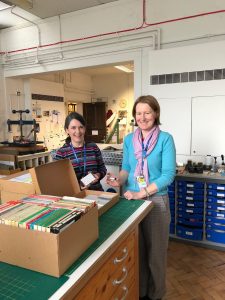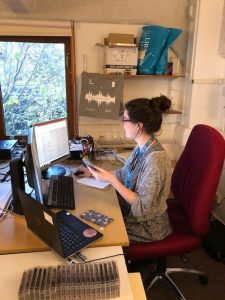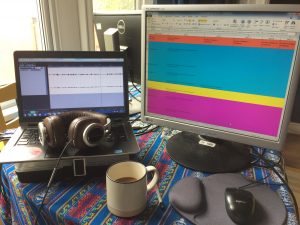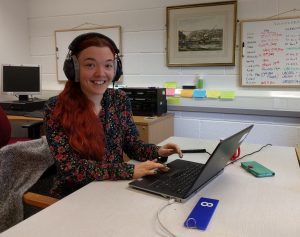Unlocking Our Sound Heritage: A day in the life of an audio cataloguer
Posted on by Fay Curtis.
by Philippa Lewis, Project Cataloguer

Meeting with colleagues at Gloucestershire Archives
Since October 2018 I’ve been working as an audio cataloguer for the Unlocking our Sound Heritage (UOSH) project team based at Bristol Archives.
This has been my first experience of working solely with audio material and I’ve really enjoyed developing my understanding of audio cataloguing. In this blog I’d like to take you through the steps that make up my work.
Working with heritage partners
As part of UOSH we work with heritage organisations from across the South West, digitising selected audio material from their collections.
The first step in cataloguing involves meeting these heritage partners in order to better understand their material and the best way to approach cataloguing it.
Cataloguing the physical items

Cataloguing cassette tapes
Now that I have an understanding of the collection, it’s time to start cataloguing.
I start by assigning each physical item (e.g. reel, cassette, minidisc) a unique reference number which will track the item throughout the digitisation and cataloguing process.
I then record information that can be determined from the items.
For example, tape boxes often have hand-written notes on them which provide useful details that can help with digitisation and cataloguing later on in the process.
Cataloguing the digitised recordings
The items are then sent down to the sound room, where the engineers will digitise them to produce WAV and Mp3 files.

Audio cataloguing from home
These files are linked to the unique reference number assigned in the first stage of cataloguing, ensuring that the physical items and digital files are permanently connected.
I am now able to complete the second stage of cataloguing. This involves listening to the digitised recordings and capturing information such as performer, date, location and content description.
I do this by listening to short segments at intervals throughout the recording. This allows me to capture the information I need whilst still ensuring I am able to process the 10,000 recordings we aim to digitise and catalogue by the end of the project.
Working with volunteers at this stage in the cataloguing process has been extremely helpful. See examples of some of the great work our volunteers have completed.
Building the Submission Information Package (SIP)

One of our volunteers, Polly, cataloguing recordings
During digitisation the audio engineers start to ‘package’ the digital files together with technical metadata to ensure their long term preservation.
This package is called a Submission Information Package (or SIP for short).
I add the relevant cataloguing information to this SIP before sending it off to the British Library through specially developed software, to be preserved in their digital archive.
Now that the recording has been preserved the whole process can begin again!
Hopefully you’ve enjoyed hearing more about how we are digitally preserving audio at Bristol Archives. See our other blogs for further information about the project and our work.